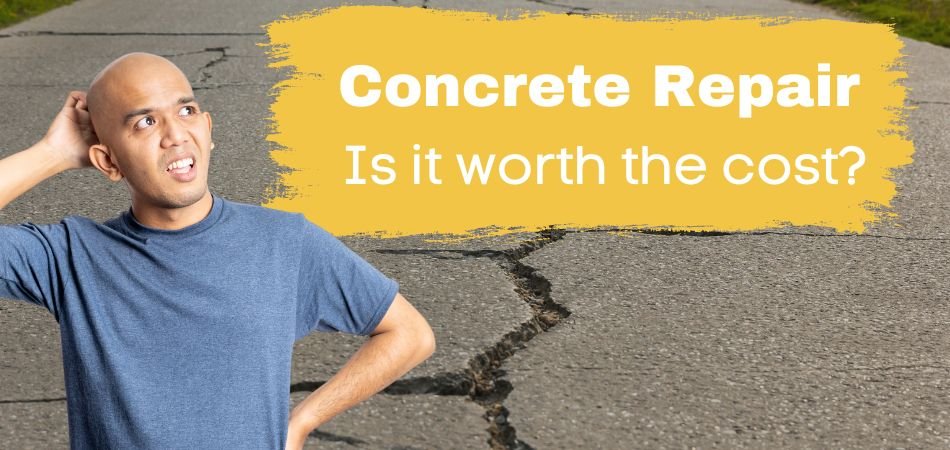


Maintaining the integrity of concrete surfaces like driveways and walkways is vital for ensuring their longevity and safety. Over time, concrete can suffer from various forms of damage, such as cracks, spalling, or deterioration due to age and weathering. When faced with deteriorating concrete, home owners have to grapple with a crucial question: is concrete repair worth the cost? In this article, we explore the various factors that should be considered before paying a concrete repair contractor. We will dive into the factors and limitations of repair so you can decide if concrete repair is a worthwhile investment. We will also share an alternative to concrete repair - rubber surfacing - that could prove to be cost effective in the long run.
Let's get started!
Factors to Consider Before Paying for Repairs
Before investing in concrete repairs or even getting quotes from contractors, several important factors should be carefully evaluated. Considering these factors will help determine whether the repair is even a feasible and cost-effective solution.
A. Age and condition of the concrete:
- Assessing the age of the concrete structure is crucial. Older surfaces may have experienced more extensive damage and spending money on repairs just won't be worth the cost.
- Evaluate the overall condition of the concrete, including the extent and severity of cracks, spalling, or other forms of deterioration.
- Determine whether the underlying cause of the damage has been addressed to prevent further deterioration.
B. Severity of the damage:
- Determine the severity and extent of the concrete damage. Superficial cosmetic issues may require less extensive repairs compared to structural damage that affect a bigger area.
- Consider whether the damage poses safety risks or affects the functionality of the structure.
- Consult with a professional concrete contractor to assess the level of damage and the necessary repairs needed to restore the concrete's integrity.
C. Structural integrity and safety concerns:
- Evaluate the structural integrity of the concrete to ensure that repairs will provide a long-term solution.
- Consider if the damage compromises the safety of the structure, occupants, or surrounding areas.
- Engage a structural engineer or a qualified professional to conduct a thorough inspection to determine the structural stability.
D. Cost of repair versus replacement:
- Compare the cost of repairing the concrete driveway, walkway or other surface to the cost of completely replacing it. Repairing isn't always economical if the repairs won't be long-lasting.
- Consider long-term expenses, including future maintenance and potential repairs if only a partial repair is done.
- Evaluate the return on investment (ROI) of the repair, taking into account the extended lifespan and functionality of the structure after repairs are completed.
By considering these factors, you'll be able to make an informed decision about whether to proceed with a concrete repair project. Each factor plays a crucial role in assessing the feasibility, cost-effectiveness, and long-term viability.

Limitations of Concrete Repair
While concrete repair can be a quick and effective solution for addressing damaged concrete, it is important to be aware of its limitations. Understanding these limitations is crucial in making informed decisions about whether concrete repair is the right choice for you. Here are some limitations to consider:
A. Limitations in addressing extensive damage or structural issues:
- Concrete repair may not be feasible for structures with severe or extensive damage, such as significant structural instability or widespread deterioration.
- In cases where the structural integrity of the concrete is compromised, repair may only provide a temporary solution, and replacement will likely be necessary in the near future.
B. Temporary solutions for underlying problems:
- Concrete repair often focuses on addressing surface-level damage, such as cracks or spalling, without necessarily addressing the underlying causes of the damage.
- If the underlying issues, such as poor drainage or soil movement, are not addressed, the repaired concrete will likely face a similar result.
C. Potential for recurring maintenance and repair needs:
- Repaired concrete structures may require ongoing maintenance and periodic repairs to maintain their integrity.
- Factors such as environmental conditions, usage, and aging can contribute to the need for future repairs, potentially resulting in additional costs over time.
D. Inconvenience and disruption during repair processes:
- Concrete repair projects can cause disruptions to normal operations, especially in commercial or public settings.
- Construction noise, restricted access to areas undergoing repair, and temporary closure of entrances or parking areas can impact a home or business and inconvenience occupants.
Make sure you weigh the potential drawbacks of concrete repair against its benefits so your money is well spent.
Rubber Surfacing as a Concrete Repair Alternative
In recent years, rubber surfacing has gained popularity as a viable alternative to traditional concrete repair methods. This innovative solution offers unique advantages and addresses some of the limitations associated with concrete repair. Here are some key points to consider regarding rubber surfacing:
A. Enhanced flexibility and durability:
- Rubber surfacing materials provide enhanced flexibility compared to rigid concrete.
- This flexibility allows the material to withstand minor movement and shifting of the underlying surface without cracking or breaking, reducing the need for frequent repairs.
B. Impact and slip resistance:
- Rubber surfacing offers excellent shock absorption properties, making it ideal for areas prone to impact, such as playgrounds, sports courts, or fitness areas. It is also an excellent choice for pool decks.
- The textured surface of rubber coatings also provides slip resistance, enhancing safety for pedestrians, especially in wet or icy conditions.
C. Versatility and aesthetic options:
- Rubber surfacing is available in a variety of colors, patterns, and designs, allowing for customization to match specific aesthetic preferences or design requirements.
- It can be used to create vibrant, visually appealing surfaces, making it a popular choice for recreational areas and outdoor spaces.
D. Ease of installation and maintenance:
- Rubber surfacing is typically installed as a seamless, poured-in-place material, reducing the need for joints or seams that can be prone to cracking or water penetration.
- Maintenance requirements are generally minimal, typically involving routine cleaning and occasional surface repairs, such as patching or reapplication of protective coatings.
E. Eco-friendly benefits:
- Rubber surfacing often utilizes recycled materials, such as shredded rubber from tires, contributing to sustainable practices and reducing waste.
- The use of recycled materials also reduces the demand for new raw materials and the associated environmental impact.
While rubber surfacing offers several advantages, it is important to assess its suitability for specific applications. Factors such as the intended use, load-bearing requirements, and exposure to harsh weather conditions should be considered when evaluating rubber surfacing as an alternative to traditional concrete repair methods.
Final Thoughts
Considering all the factors involved in a concrete repair project and the extent of the damage, you can see how repairing an existing surface can be a gamble. A concrete contractor may tell you that repairs will be good for the next few years, but beyond that, the structural issues will cause damages to recur. If you don't want to waste money on a costly repair and would rather invest in your concrete surface wisely, consider Rubber Stone.
We would love to explain how Rubber Stone works and why a cracked or damaged surface doesn't need to be repaired for Rubber Stone to effectively do its job for years to come.
Give us a call or fill out the quote form to get started.
